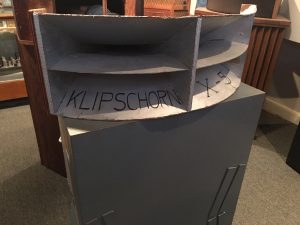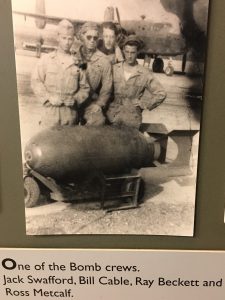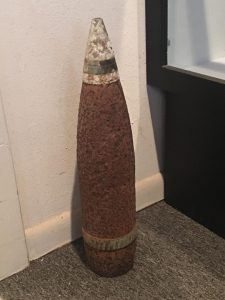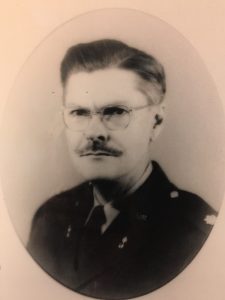Prove It To Me: How Hempstead and Surrounding Counties’ Proving Grounds Produced Not Only Area Jobs, Created “A Legend In Sound”, and Helped Win World War II
By Scott Jester, 11/30/21 3:30 PMIt may be hard for some, but try and imagine what it may have been like fighting in a war zone along with your brothers-in-arms during World War II. The fighting has been intense and you pray for relief.
In the background, you recognize the familiar sound of the mammoth bomber lumbering her way with a payload of warheads loaded with bad intentions for the enemy.
Most ordnances activate and complete what they were sent to do in an overarching goal of restoring peace to a world gone mad.
But numerous shells dropped to the earth and left nothing more than a small pit in the ground without detonating, or exploding in an unintended area.
Numerous other “duds” landed on our own troops. Killing or wounding them.
It was not the intended conclusion to its journey with so much work going into that piece of steel and metal and brass.
And even more work that went into that lost soldier and who was somebody’s son.
For those readers who were raised during the war effort in this particular area during the first half of the 1940’s, quite a transformation took place just north of the train depot in downtown Hope.
The Southwest Arkansas Proving Ground was constructed and it conducted war business into 1945 until the finality of the War.
In June of 1941, the airport was constructed as part of the National Defense Program which was the backbone of the war effort, converting industries into munitions productions, tank and airplane construction throughout the country as our country was prepping to join the War.
When word arrived in Hope/Hempstead County that a proving ground would be constructed beginning soon, there had to be quite a few who scratched their heads wondering how and where more than 400 families would be relocated within 60 days to make room.
It was done.
The seriousness had set in the locals’ homes that while they themselves may not have gone to the War “over there”, the War had come to them, over here, in Hempstead County.
What happened was a staggering display of speed and militaristic perfection. More than 4,000 workers were hired with preference given to local applicants to help get it ready.
The Proving Ground first consisted of a large airport and airstrips, which remain active to this day.
Did you know at the time of its construction, it was the third-longest runway in the United States?
Hundreds of buildings were constructed necessary to see successful operation from powder magazines, turret houses, a (ADD “MULTIPLE”) steam heating plants, the all-important Telephone Exchange Building, which is on the prestigious Arkansas list of Historic Places.
They even constructed and operated a hospital on the Proving Ground, because unfortunately, accidents, will happen.
Ironically, the Opening Day ceremonies planned for the Proving Ground airport were postponed because of the bombing of Pearl Harbor, Hawaii, on December 7, 1941.
It was a direct attack on American territory which meant the Japanese wanted more of us and our country. Talk about a real call to action.
One of the veterans who didn’t come from the local area who would serve at the new Proving Ground was Paul Wilbur Klipsch.
He was placed here by Uncle Sam because of his wealth of engineering knowledge and “other” qualities. He would serve as a Major during the war then afterwards was ranked as Lieutenant Colonel.
Klipsch was the only child of Oscar Klipsch and Minna Pearl Eddy in Elkhart, Indiana in the spring of 1904. He was a graduate of New Mexico State University and worked for General Electric designing, of all things, radios.
Meet Jim Hunter, Curator of the Paul W. Klipsch Museum of Audio History, which served as the Telephone Exchange Building with its ultra-thick concrete walls and reinforced basement during the War.
Hunter, a tall, affable man with a radio-rich-type voice is the ultimate guide.
The Museum/Exchange building was located in strategic location to the Engineering Building across the street (which is the current location of the Klipsch Manufacturing building) and just down the street from Headquarters and only a quarter-mile from the actual firing line.
“The building was built for $49,000,” said Hunter during a brief description on how much had gone into the construction of this critical communications building. “Today, that would be $840,000,” Hunter said. “It was built to withstand bombs and was the reason why Paul Klipsch came here.”
Ever seen a uniform breathe? Ever seen one come alive on its own? It happened in the Klipsch Museum just after a package containing the actual dress military uniform worn by Klipsch in the picture you see posted arrived and I had the opportunity to take it out for one of the first times.
Maybe it’s simple over-emotion, but to have the opportunity to hold the actual heavy, wool uniform in your hands, run your fingers over the buttons and insignias with gentle but immense respect. One can almost feel the uniform breathe in the air of the old building where it had spent time through its fabric again and transport somehow back to a time when it was on the shoulders of a young someday-legend. “A Legend in Sound”.
First, he had a responsibility to his country. Klipsch originally served as the chief engineer at the Proving Ground. He oversaw the chronograph department, which measured speed of the munitions as they passed through timing and performance areas, taking valuable data of differing designs.
It was Americans operating at their best. Free to think and use their God-given talents, blended with other strangers who came to the United States with a common-goal. Freedom.
“In the beginning of the war, the 105mm Howitzer shells’ duds were falling on our troops,” Hunter disclaims. “He (Klipsch) patented a method which tested the rotating bands (sealing the cartridge to the projectile.) to make sure they were a good round (and kept them from killing our servicemen).”
Many may not know that Klipsch was headed in other directions figuratively and literally before being called into service. “He was in his oil prospecting phase in Houston when they punched his ticket,” said Hunter.
“He was all over the place,” Hunter continued. “This was his third career. He had already patented a couple of small arms and got his third ballistics patent here at the Proving Ground.
“He was a renaissance man,” said Hunter. “He did a little bit of everything.”
Klipsch’s father was an instructor and taught how to make and maintain boilers, which were in high demand during the period at Purdue University, which goes by their name of “Boilermakers” today.
“His father ended up with Tuberculosis, so in his early teens they had to move to the Southwest for the weather, but he died while Paul was a teen,” Hunter recounted. “Klipsch took up with the Pueblo Indians and going to a Christian church with them,” Hunter said
“His curiosity (about sound) had been inflamed in Houston in the mid ‘30s,” Hunter noted. “Bell Telephone had an extremely good speaker system for large venues and they brought the demonstration around.
“He went to see one and went home and made the back bedroom into a workshop, so it was his “hobby” during his prospecting days,” Hunter said. “So, in his spare time, he designed his first Klipschorn in his Officer’s Quarter’s bedroom when he was at the Proving Grounds” he says with a chuckle.
Klipsch is a reminder of President Teddy Rosevelt who served at the early turn of the century. Klipsch seemed to have a zeal and almost voracious appetite for life and learning, for testing his brain, for working without fear. Advancing thought. Advancing other curious types. He was a living legend. And he lived in Hope, Arkansas.
Klipsch remained in Hope into the 1980’s and many locals were familiar with Klipsch wearing multiple watches. For those who didn’t know him, they regarded him as eccentric and possibly in need of help.
He, in turn, would consider you, the one who would’ve been in need of help, noting wearing two wrist watches and a pocket watch had a very good explanation. As a man who was constantly travelling, “One was set for departure time. One was set for arrival time. And, the pocket watch was set at Grenwich mean time,’” Hunter recounts as if it was as natural as, well, as telling time.
The building in which we stood was originally known as “Building 116” which served as the telephone exchange for the entire proving ground facility.
The building and its many connections to the entire proving ground and its partners around the country provided real-time experiences which led to alterations made to the shell.
Historian Peggy Lloyd is a local treasure, born in Hope in 1943, she remains the go-to person for how to perfectly add to this story. Her father was in the army after being drafted in 1942 and her family was immediately swept up in the groundswell that was the Proving Ground. “My mother and father ran a store that was located on the proving grounds and they got their store,” Lloyd began. “They took a total of 50,098.6 acres for it,” she stated matter-of-factly.
“There were a lot of family farms out there,” she continued. “My grandfather was forced to sell his farm to the government and it was located on Highway 46.”
Getting the locals to comply with a major land takeover wasn’t near as difficult during that period as many understood the gravity of the approach of WWII and would do anything to help assist in the mission.
Imagine trying to complete such a feat in today’s society.
“Some people resisted and they filed lawsuits against them,” Lloyd said, “but they (the government) took it by imminent domain. Many for the better of the country and Dad was already fighting, so it was pretty certain the War was going to happen.”
Some may remember Hope Star Editor Alex Washburn was noted for his weighty opinion columns and general views on life, business, and generally what was good for our corner of Arkansas.
Washburn noted at the time, “…anybody can see things about the Proving Ground to break your heart – but it is admittedly the biggest thing in South Arkansas since the El Dorado oil boom in 1921.” (Many thanks to Arkansas Heritage.com for the quote.)
It was hats off at the time to Senator George Lloyd Spencer, who spearheaded the move to bring the Proving Grounds to Hempstead County. Already a WWI veteran, Spencer served as a local banker at the time and had farmland where the Proving Grounds is located.
It was quite heady times for Hempstead and the surrounding counties with what was happening during those years. The population of Hope and other towns increased as men and their families moved closer to the area as they became involved in the Proving Ground. There was a blending of soldiers and civilians which can be tricky. Service men were bussed in from the surrounding areas.
And once established, the “proving” of the Proving Grounds was not a quiet work area with large aircraft constantly coming and going, not to mention the loud explosions and accidents.
All of it still proved the mettle of the citizens, many are/were your relatives, who continue to comprise Hempstead and the surrounding counties of who contributed to that war effort. In a sense, their lives depended on an American victory.
Lloyd’s mother was later hired to work with Klipsch and she was working by setting up weather balloons for him. “They got along fine because she had good basic math skills,” Lloyd remarked.
“The officer who was to introduce her, said to her, ‘Mrs. Lloyd, we don’t want you to be alarmed at anything that Major Klipsch may say or do in your interactions,’
And then he (Klipsch) walks in, sits in the trash can, and begins discussing something,” Lloyd says with a chuckle.
But that’s it. All this action in and around the Proving Ground. All the interesting and talented people.
One of the best things to remain from the Proving Ground is Paul W. Klipsch was “ours”. After the war, he continued to work on his outstanding discoveries in sound, producing some of the finest quality loudspeakers designed for concert halls, theatres, and homes around the WORLD!
It was a local fact that many living in the area of the Proving Grounds were treated to many concerts as the factory would open their doors and test their products with beautiful music. All “this” in our backyards in Hempstead County and surrounding areas.
However, after the war, and they closed the Proving Grounds, Klipsch wasn’t fully accepted by everyone.
“Conservative elements in Hope felt that if that continued out there, it would have a negative effect on the “moral character” of Hope,” Lloyd recounted with a smirk.
“After the War, numerous folks in the area were accidentally killed by unexploded ordnances,” said Lloyd. “They wanted to pick them up to recycle the metal,” Lloyd said.
“There was a family where several were killed. The shells had brass on them.
There were other tragedies where a mother was hanging clothes to dry and a shell’s shrapnel injured her severely and the local pilot was harshly affected about accidentally injuring a local.,” Lloyd recounted.
Many live ordnances remain in the area, they are recovered accidentally all the time. Please treat them with respect, because the ordnances do not discriminate. Call the authorities if found, please.
But, all things considered, the Proving Ground helped shape this area while playing a key role in the victory of World War II
After it’s conclusion, much of what is now our industrial area evolved from that landscape.
And, we were given the gift Paul W. Klipsch. He was placed in Hope and Hope is where he stayed after the war. He created and manufactured his world-wide beloved products here. In the backyard of our hometown.
He could have chosen ANYWHERE in the world to live after the War. However, he chose Hope.
Hope, Arkansas was his home.
There is gobs of information and terrific photos and displays to research about the Proving Grounds at the museum located INSIDE the tower at Hope’s airport and more online. It’s also a treat for kids to tromp around some of the area near the airport.
For more of the wonderful history on Paul Klipsch, simply go to Klipschmuseum.org. Please call Jim Hunter and arrange a one-on-one visit with him. It will be well worth your time and then some.
A good source says to expect in the future, a travelling exhibit on the Proving Grounds provided through the McCarther Museum in Little Rock! (Remember, you read it here first.)








